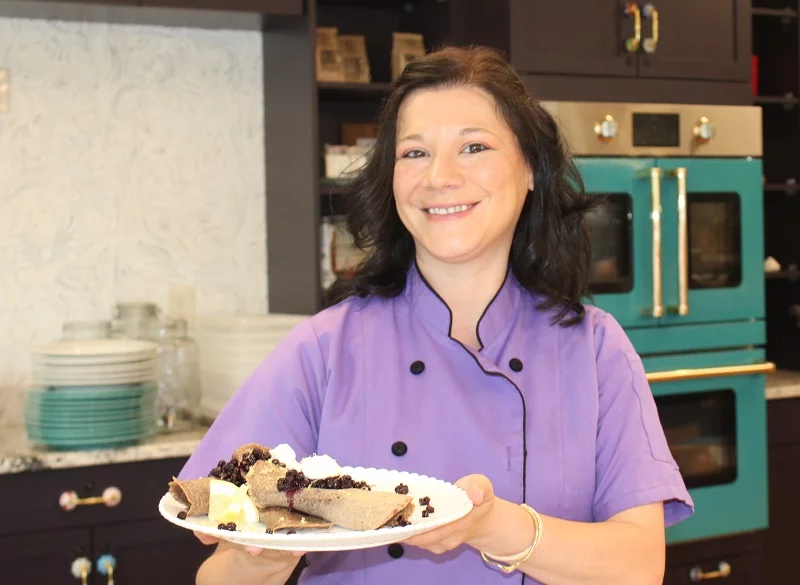
Crepes have a much lighter batter than pancakes, which reduces calorie and carb intake without sacrificing flavors or a breakfast favorite.
Chef Aarika Ortiz, shares her recipe so you can learn how to make these delicious gluten-free and high-protein crepes.
Ortiz explains that buckwheat crepes hail from the Brittany region of France. Buckwheat is a healthy alternative to wheat flour. It contains a higher percentage of protein and fiber, than traditional flour. It also contains antioxidants and minerals.
You can add anything to a crepe but think of crepes as a great excuse to use up some vegetables in the fridge or whip up a blueberry compote.
Blueberries are a superfood and are rich in antioxidants. By simply reducing them down in water, lemon and honey, you can create a wonderful filling or topping for your buckwheat crepes.
Buckwheat crepes with blueberry compote

Ingredients (makes16 crepes)
- 2 cups whole milk
- 1 tablespoon sugar
- 1/4 tablespoon sea salt
- 3 tablespoons melted butter
- 1/2 cup buckwheat flour
- 3/4 cup flour (can substitute gluten free flour)
- 3 eggs
Preparation
In a blender, or using a whisk, mix all the ingredients until smooth.
Cover and chill at least 2 hours or up to overnight.
Remove the batter from the refrigerator about an hour before cooking.
Stir briskly.
The consistency will be similar to heavy cream.
Heat a non-stick skillet and add a tablespoon of butter to coat the bottom of the pan. Make sure that all the edges of the pan are coated. You only need to do this every few crepes to ensure it won’t stick. Pour just enough batter to coat the bottom of your 8-to-9-inch skillet. You’ll use approximately 1/4 cup or less.
Add the batter to the center of the pan and tilt the pan quickly so the batter distributes to the edges equally.
After only a minute, run a non-stick spatula around the rim of the crepe. it should loosen up. If it sticks, it isn’t ready to flip yet. Once it is loose, tilt the pan forward, and flip the crepe towards yourself.
You can also use a spatula to flip it into the pan. Let it cook for another 20 seconds and slide onto a plate. Fill with the blueberry compote or roll and top.
Blueberry compote
Ingredients
- 4 cups fresh blueberries
- 1/2 cup water
- 2 tablespoon fresh lemon juice
- 1/3 cup sugar
- ½ teaspoon vanilla extract (optional)
Preparation
Add the ingredients to a pot and heat to a boil. Lower heat and stir. Continue to simmer on low for 30 minutes and mash lightly. Remove from heat and cool.
Nutritional information and macronutrient breakdown
One buckwheat crepe (large)
- 161 calories, with about 6.4g of protein and 8.9g of fat
- Good source of various nutrients including B vitamins, phosphorus, magnesium, iron, zinc, copper, and manganese
- 1 cup blueberry compote contains 251 calories
- 97% carbs, 2% fat, and 2% protein
- Good source of fiber (26% of your daily value)
- Vitamin C (36% of your daily value)
- Vitamin K (48% of your daily value)
